A veteran of the horror genre, Bill Skarsgård, who has embodied many iconic roles, delivers yet another standout performance in Nosferatu.
The gothic horror film has earned critical acclaim for its lead actors, with Lilly Rose Depp and Nicholas Hoult drawing the most admiration from critics. What truly set the film apart, however, was Bill Skarsgård’s chilling portrayal of Count Orlok. Bill Skarsgård's haunting performance as Count Orlok ultimately stole the spotlight as the film’s defining strength.
Skarsgård’s take on Orlok stands out distinctly, not only from the 1922 rendition but from the entire canon of vampire lore. His version of Count Orlok breaks away from the broader tradition of vampire narratives. Orlok’s visual design has remained mostly hidden in the promotional material for Nosferatu. Eggers referred to aim as a revival of the “Scary, rotting corpse” tradition of horror monsters, distancing the character from the polished, sensual vampires of recent years.
Thanks to Eagger’s version, the 34-year-old actor reshaped Orlok for contemporary audiences, firmly establishing himself among the genre’s legends. His character is captivating, unforgettable, and pure nightmare fuel. Through this article, we will talk about 7 ways Bill Skarsgård's portrayal of Count Orlok in Nosferatu differs from typical vampires in movies.
Corpselike appearance
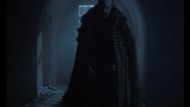
Forget the suave, elegant vampires with chiselled features. Now you’re going to meet with a monster that seems ripped straight from the Earth itself. The era of dashing, refined undead with sculpted cheekbones is over. Bill Skarsgård’s nightmarish Orlok in Nosferatu gives the boot to the modern-day, glittered, drenched vampire heartthrobs. Under layers of disturbing prosthetics, Skarsgård is tuned into a death-like monster flesh, festering, bone exposed, and the unnatural, puppet-like gait of something that hasn’t drawn breath in centuries.
Far from the seductive bloodsuckers of high school dramas and gothic love stories, this version of Orlok doesn’t flirt; he frightens. Meant to channel a once regal, long-deceased Transylvanian lord, Bill Skarsgård’s look is steeped in withered decay, not youthful immorality. It embraces the vampire myths of old, a less polished aristocrat, more ghoul lurking in a tomb. Skarsgård fully embodies the role; his movements feel ancient, as though bound by time, with a haunting stillness that creeps under your skin. Skarsgård reminds us that vampires once symbolized horror, not heartbreak. Forget the lonely immortal with a heartache; this is a rotting wraith with feral hunger in its eyes.
Historical authenticity
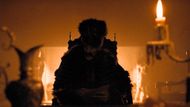
Forging the usual dark cape and modern vampire chic, Skarsgård’s version of Orlok feels ripped out of the Renaissance era. Unlike the stereotypical vampire, his Count Orolok carries an uncanny sense of living in antiquity that feels ripped from another century. There’s historical accuracy in his portrayal. Draped in traditional Hungarian costume, and aristocratic accents that hint at his formal Transylvanian nobility. Bill Skarsgård taps into the concept that Orlok was more than a nocturnal predator; he was a man of stature, bloodline, and a legacy that once held significance.
It’s more than aesthetic; the costumes are intentionally crafted to enhance the narrative. The costumes root him firmly in a tangible era and region, making him feel like a figure from Eastern European lore rather than a product of Hollywood horror. They gave the character a strong sense of time and place. A subtle creepiness lingers in the way Bill Skarsgård inhabits these garments, like the dignified shadow of a nobleman who’s been dead for centuries. This isn’t a vampire born of smoky clubs or deserted city streets; he brings horror straight from a windswept castle lit only by candlelight.
His Voice
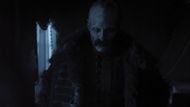
Any conversation about Bill Skarsgård’s portrayal of Count Orlok has to begin with his unmistakable voice. You just can’t ignore that; you have to acknowledge that voice that somewhere sets it all in motion. What sets Skarsgård’s Count Orlok apart in the most bone-chilling way is something subtle but seared into memory: his voice. If you know anything about Skarsgård, you will recognize that his actual voice is not like that; it’s much younger and more relaxed than the deep, deliberate cadence he uses as Orlok.
Instead of the slick, alluring voices we typically hear from cinematic vampires, Skarsgård’s Orlok growls in a raspy, guttural tone that feels painful to produce. His choice of voice breaks away from the standard vampire formula in a bold way. You won’t find anything seductive here; what’s left is a harsh, guttural rasp that crawls under your skin. His voice drags each word out with difficulty and making the atmosphere more intense. In Nosferatu, Skarsgård’s voice adds more than sound; it intensifies the atmosphere of terror.
Hidden shadowy reveal
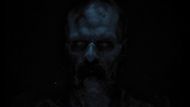
Nosferatu deliberately keeps Orlok obscured, shrouded in gloom or lingering off-screen for nearly the first half. His voice paired with the character’s disturbed responses set the stage long before his discomposing body comes into full view. Where most vampire movies reveal their monsters early and often, Bill Skarsgård’s Orlok stays just out of frame, concealed behind curtains, lurking in murky passageways, or glimpsed through the terror of his victims. This gradual buildup is incredibly effective. Bill Skarsgård haunts the screen long before he ever fully appears.
His haunting outline, fleeting flashes of gnarled fingers, or the faint sound of his breath are more than enough to make your skin crawl. This is the slow-burning dread that keeps you leaning in, anxious to see when and in what form the monster will emerge. The suspense grips you, drawing you closer as you anticipate the inevitable reveal of the full horror. Bill Skarsgård’s eventual appearance is striking and as haunting as you’d hope, but it’s the lead-up that leaves a lasting impression. His presence off-screen is every bit as chilling as his moments in the spotlight. Choosing suspense over spectacle, Nosferatu breaks from modern vampire trends, and Skarsgård makes every fleeting shadow unforgettable.
Drinking from the heart

While most vampires go for the neck because, you know, it’s neat, quick, and conveniently dramatic, Orlok takes a far creepier route: he drinks blood straight from the heart. Yes, the heart. Right through the chest. It’s brutal, messy, and not exactly practical, there’s a breastbone in the way, after all, but that’s what makes it so effective. Bill Skarsgård leans into vampire folklore with this move. Old legends didn’t paint vampires as seductive neck-nibblers; they described them as terrifying creatures that sat on victims’ chests, causing pressure and fear, kind of like sleep paralysis.
Orlok’s feeding style brings that idea to life in the most literal and horrifying way. Instead of romance, there’s raw horror. Instead of a delicate bite, there’s a monstrous act that feels more animal than human. Bill Skarsgård’s performance doesn’t just rely on looks or mood; he embodies a primal force, something ancient and absolutely terrifying. It’s a small detail, but it speaks volumes about the kind of vampire Orlok is. By choosing the heart over the neck, Nosferatu reminds us that this creature isn’t here to charm; he’s here to haunt. And Skarsgård makes every gruesome second count, giving us a vampire who’s more nightmare than fantasy.
Predatory obsession, not romance
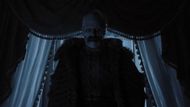
Unlike the typical vampire who oozes charm and tragic romance, Skarsgård’s Orlok is driven by something much darker. His obsession with Ellen Hutter isn’t love or even longing, it’s a twisted, predatory fixation that feels more like a hunt than a courtship. There’s nothing sweet or seductive about it. Skarsgård plays Orlok’s interest in Ellen as a creepy, controlling lust, rooted in dominance and desire for power. It’s almost like a twisted fetish; he doesn’t just want her blood, he wants to own her spirit. It's the kind of disturbing, that you can't look away from.
While many modern vampires lean into tortured stares and love triangles, Bill Skarsgård throws all of that out the window. He wants to consume, to possess, to feed off someone’s light. It’s deeply unsettling, and that’s exactly the point. This portrayal takes vampires back to their terrifying roots. There’s no sparkle, no sighs, just a creeping sense of danger. Skarsgård’s Nosferatu reminds us that vampires weren’t always heartthrobs. Sometimes, they were just monsters in the shadows, and Orlok fits that mold perfectly.
No vampire creation
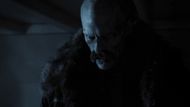
Unlike others, Bill Skarsgård’s Count Orlok is driven purely by his insatiable thirst for blood, and that ruthless focus makes him different from any other vampire we’ve seen. You won’t be able to find any charming proposal of unending existence in Nosferatu; there’s no turning, only taking. In contrast to the vampires of contemporary films who bite to turn lovers or followers, Skarsgård’s Orlok doesn’t recruit; he feeds or commands, and that’s where it ends.
Bill Skarsgård leans hard into this idea, stripping away the idea of a vampire as a dark mentor or romantic recruiter. Victims don’t rise again with fangs and powers. They suffer, they wither, or they fall under his spell. It’s about domination, not companionship. This lack of transformation sets him far apart from today’s vampire crowd. Just one monster, feeding and moving on. It keeps the story grim and grounded in dread, instead of turning into a supernatural soap opera.
By avoiding the usual vampire recruitment arc, Nosferatu puts the focus squarely on fear. And Skarsgård delivers that fear in every moment. His Orlok doesn’t build a legacy; he erases others. That makes him feel more like a force of nature than a gothic heartthrob, and that’s exactly what sets this performance apart.
Love movies? Try our Box Office Game and Movie Grid Game to test your film knowledge and have some fun!
